At the 18th annual Sustainable Business and Design Conference, April 9 and 10, innovators across the sustainability spectrum shared their experiences and their vision for a cleaner tomorrow.
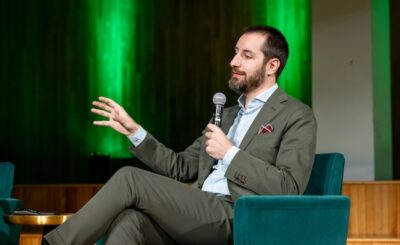
One focus was building a transparent, ethical supply chain with a light environmental footprint. Gabriele Camozzi, head of marketing for the Albini Group, an Italian fabric producer that sells to numerous luxury fashion brands, spoke with Salvatore Giardina, assistant professor of Production Management, about how his company gained control over every aspect of their supply chain, from growing cotton to the final weaving and dyeing processes. Camozzi said Albini pushed its farms to adopt organic methods, and that the company can take a chemical fingerprint of the cotton on a farm and confirm that fiber was used in the final dress shirt.
He believed other companies could emulate Albini’s sustainable practices. “It’s a cultural change that we need to do together—we are all in this together.”
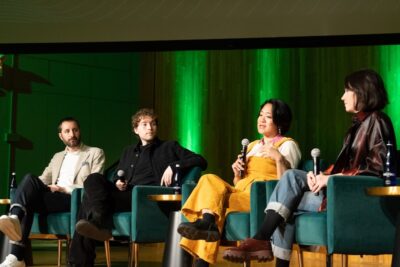
Albini has an innovation arm called ALBINI_next tasked with creating green materials and processes, and in a panel on the second day of the conference, Camozzi spoke about the next generation of sustainable fibers with other innovators: alum Chui-Lian Lee, cofounder and CEO of Werewool, a startup that is creating eco-friendly performance textiles using engineered microbes; and Max Cheng, senior marketing associate for Keel Labs, a company creating seaweed-derived fibers. The idea for those two companies came out of FIT’s participation in the Biodesign Challenge.
The panel participants talked about the importance of collaboration when creating a new textile from scratch and growing a startup. “At first, you don’t have the infrastructure even to make a swatch,” Cheng said.
“When you’re looking for funding,” Lee added, “you need to be resilient and take each ‘no’ as a piece of armor.”
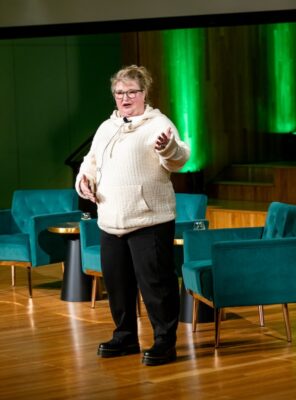
In an impassioned keynote speech, Stacy Flynn, Textile Development and Marketing ’98, talked about founding Evrnu, a company that develops new fibers made from waste material. Bringing Evrnu’s products to market have required surmounting two major challenges, not only creating fibers that are stronger and softer than existing fibers but also convincing skeptical companies to adopt them.
“We’re stuck in this spot of knowing we need to change and not being able to change at the same time,” she said.
She turned to fellow alum Christopher Bevans to make fashion out of Evrnu’s regenerated fiber Nucycl. They started with a stylish hoodie that Flynn wore during her talk.
“I wear it when I negotiate,” she said. “It gives me that extra boost.”
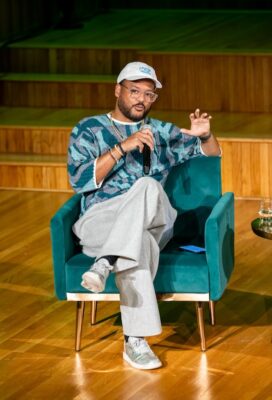
Bevans joined Flynn on stage to talk more about the partnership. “I’m thankful I can hitch my wagon to this,” he said. “It’s the most important collaboration I’ve ever done.”
One reason for the success of their partnership, they said, was that their values are aligned. “The mind can only repeat what it knows—the mind will always play it safe,” Flynn said. “If you want to do something in the world that’s never been done, you need to tap into a much deeper resource, and that’s the heart. If you can get to the soul, you’re aligned with nature. You’re free.”
Other presenters addressed the emotional component of sustainability as well. Ethan Lu, assistant chair of Interior Design, moderated a panel about eco-inspired environments with Dr. Tuwanda Green, an expert in biophilic design, and Robert Hammond, who cofounded the restoration of the High Line, which is now one of the most popular attractions in New York City.
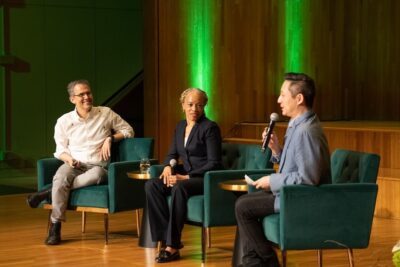
Green discussed the science behind spaces with a connection to natural light and sounds. When people don’t have access to nature, she said, “little by little it’s changing your body, it’s taking you out of homeostasis.”
Hammond spoke about the importance of outdoor designed spaces in cities. The High Line, he said, “creates a social space in nature.” And even though people complain of the crowds, he adds that “people have better social interactions in nature than outside of nature.” Now 8 million people visit the High Line annually, a million more than the Metropolitan Museum of Art, which is 30 times bigger.
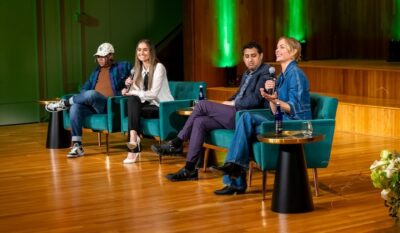
Amber Valletta, a model, actress, entrepreneur, and activist who serves as FIT’s Sustainability Ambassador, moderated a panel of young climate activists addressing the need for self-care when facing down the existential crises of our time.
Sophia Kianni, founder of Climate Cardinals, an organization that promotes climate education to those who don’t speak English, disconnects from her work and her phone on Saturdays to restore some balance. “The times in my life I’ve been the most overwhelmed, it’s because I’ve been chronically online,” she said. “It always felt that there was noise in my head and I couldn’t shut it off.”
Climate activist Vic Barrett, a plaintiff in Juliana v. United States, a lawsuit against the government to take action on climate change, also needs to relax sometimes. “I find a lot of peace sharing TikToks with the homies and having picnics in the park,” Barrett says, “and not talking about this existential crisis we’ve all been working on for a really long time.”
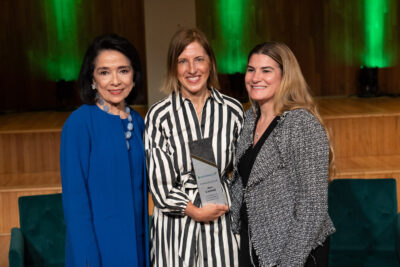
The conference concluded with a ceremony honoring this year’s Changemaker: Ann Cantrell, associate professor of Fashion Business Management. Cantrell has served in numerous roles supporting sustainability at FIT, including two terms on FIT’s Sustainability Council. She also developed a required course for the FBM program, Circular Economy for Sustainable Fashion Business, among many other accomplishments.
The conference was organized by Dr. Colleen Hill, curator of Costume and Accessories at The Museum at FIT, and Andrea Diodati, assistant professor of Fashion Design, with assistance from Dr. Karen Pearson, chair of Science and Math and chair of the Sustainability Council.
